Taeyoung Kim
HAMLET: Switch your Vision-Language-Action Model into a History-Aware Policy
Oct 02, 2025Abstract:Inherently, robotic manipulation tasks are history-dependent: leveraging past context could be beneficial. However, most existing Vision-Language-Action models (VLAs) have been designed without considering this aspect, i.e., they rely solely on the current observation, ignoring preceding context. In this paper, we propose HAMLET, a scalable framework to adapt VLAs to attend to the historical context during action prediction. Specifically, we introduce moment tokens that compactly encode perceptual information at each timestep. Their representations are initialized with time-contrastive learning, allowing them to better capture temporally distinctive aspects. Next, we employ a lightweight memory module that integrates the moment tokens across past timesteps into memory features, which are then leveraged for action prediction. Through empirical evaluation, we show that HAMLET successfully transforms a state-of-the-art VLA into a history-aware policy, especially demonstrating significant improvements on long-horizon tasks that require historical context. In particular, on top of GR00T N1.5, HAMLET achieves an average success rate of 76.4% on history-dependent real-world tasks, surpassing the baseline performance by 47.2%. Furthermore, HAMLET pushes prior art performance from 64.1% to 66.4% on RoboCasa Kitchen (100-demo setup) and from 95.6% to 97.7% on LIBERO, highlighting its effectiveness even under generic robot-manipulation benchmarks.
Contrastive Representation Regularization for Vision-Language-Action Models
Oct 02, 2025Abstract:Vision-Language-Action (VLA) models have shown its capabilities in robot manipulation by leveraging rich representations from pre-trained Vision-Language Models (VLMs). However, their representations arguably remain suboptimal, lacking sensitivity to robotic signals such as control actions and proprioceptive states. To address the issue, we introduce Robot State-aware Contrastive Loss (RS-CL), a simple and effective representation regularization for VLA models, designed to bridge the gap between VLM representations and robotic signals. In particular, RS-CL aligns the representations more closely with the robot's proprioceptive states, by using relative distances between the states as soft supervision. Complementing the original action prediction objective, RS-CL effectively enhances control-relevant representation learning, while being lightweight and fully compatible with standard VLA training pipeline. Our empirical results demonstrate that RS-CL substantially improves the manipulation performance of state-of-the-art VLA models; it pushes the prior art from 30.8% to 41.5% on pick-and-place tasks in RoboCasa-Kitchen, through more accurate positioning during grasping and placing, and boosts success rates from 45.0% to 58.3% on challenging real-robot manipulation tasks.
Analysis of Fourier Neural Operators via Effective Field Theory
Jul 29, 2025Abstract:Fourier Neural Operators (FNOs) have emerged as leading surrogates for high-dimensional partial-differential equations, yet their stability, generalization and frequency behavior lack a principled explanation. We present the first systematic effective-field-theory analysis of FNOs in an infinite-dimensional function space, deriving closed recursion relations for the layer kernel and four-point vertex and then examining three practically important settings-analytic activations, scale-invariant cases and architectures with residual connections. The theory shows that nonlinear activations inevitably couple frequency inputs to high-frequency modes that are otherwise discarded by spectral truncation, and experiments confirm this frequency transfer. For wide networks we obtain explicit criticality conditions on the weight-initialization ensemble that keep small input perturbations to have uniform scale across depth, and empirical tests validate these predictions. Taken together, our results quantify how nonlinearity enables neural operators to capture non-trivial features, supply criteria for hyper-parameter selection via criticality analysis, and explain why scale-invariant activations and residual connections enhance feature learning in FNOs.
Fourier Neural Operators for Non-Markovian Processes:Approximation Theorems and Experiments
Jul 23, 2025Abstract:This paper introduces an operator-based neural network, the mirror-padded Fourier neural operator (MFNO), designed to learn the dynamics of stochastic systems. MFNO extends the standard Fourier neural operator (FNO) by incorporating mirror padding, enabling it to handle non-periodic inputs. We rigorously prove that MFNOs can approximate solutions of path-dependent stochastic differential equations and Lipschitz transformations of fractional Brownian motions to an arbitrary degree of accuracy. Our theoretical analysis builds on Wong--Zakai type theorems and various approximation techniques. Empirically, the MFNO exhibits strong resolution generalization--a property rarely seen in standard architectures such as LSTMs, TCNs, and DeepONet. Furthermore, our model achieves performance that is comparable or superior to these baselines while offering significantly faster sample path generation than classical numerical schemes.
Mixed-Session Conversation with Egocentric Memory
Oct 03, 2024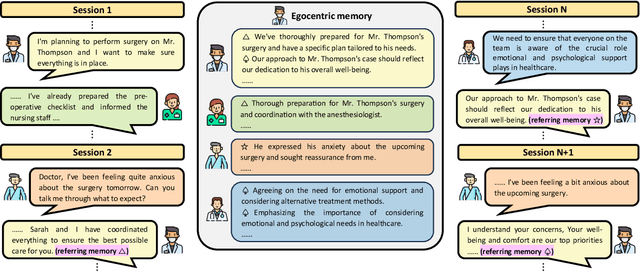
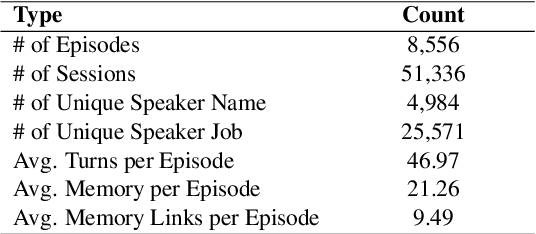


Abstract:Recently introduced dialogue systems have demonstrated high usability. However, they still fall short of reflecting real-world conversation scenarios. Current dialogue systems exhibit an inability to replicate the dynamic, continuous, long-term interactions involving multiple partners. This shortfall arises because there have been limited efforts to account for both aspects of real-world dialogues: deeply layered interactions over the long-term dialogue and widely expanded conversation networks involving multiple participants. As the effort to incorporate these aspects combined, we introduce Mixed-Session Conversation, a dialogue system designed to construct conversations with various partners in a multi-session dialogue setup. We propose a new dataset called MiSC to implement this system. The dialogue episodes of MiSC consist of 6 consecutive sessions, with four speakers (one main speaker and three partners) appearing in each episode. Also, we propose a new dialogue model with a novel memory management mechanism, called Egocentric Memory Enhanced Mixed-Session Conversation Agent (EMMA). EMMA collects and retains memories from the main speaker's perspective during conversations with partners, enabling seamless continuity in subsequent interactions. Extensive human evaluations validate that the dialogues in MiSC demonstrate a seamless conversational flow, even when conversation partners change in each session. EMMA trained with MiSC is also evaluated to maintain high memorability without contradiction throughout the entire conversation.
Why Rectified Power Unit Networks Fail and How to Improve It: An Effective Theory Perspective
Aug 04, 2024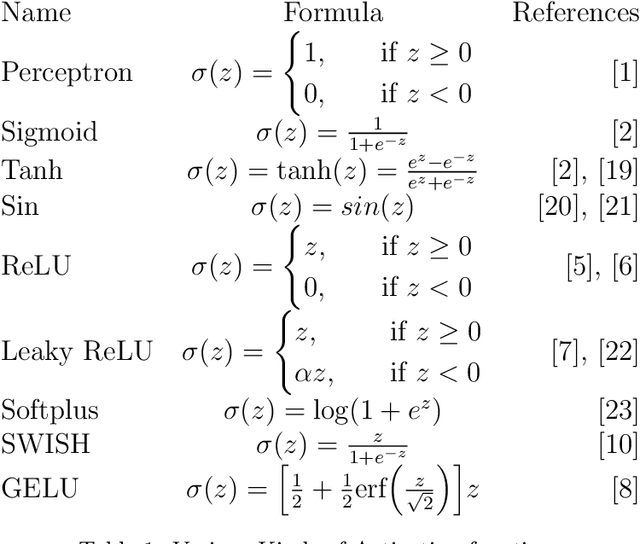
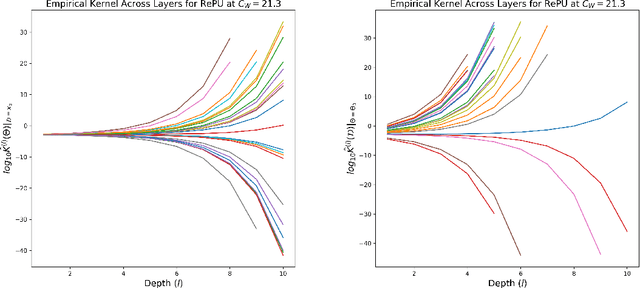
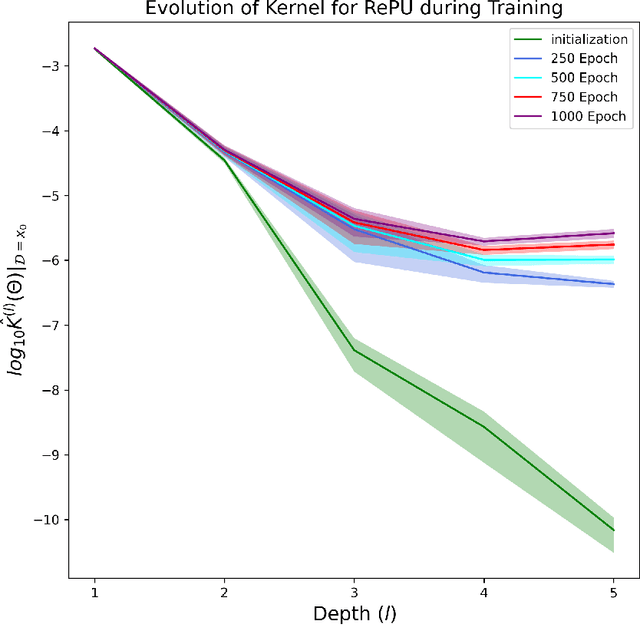
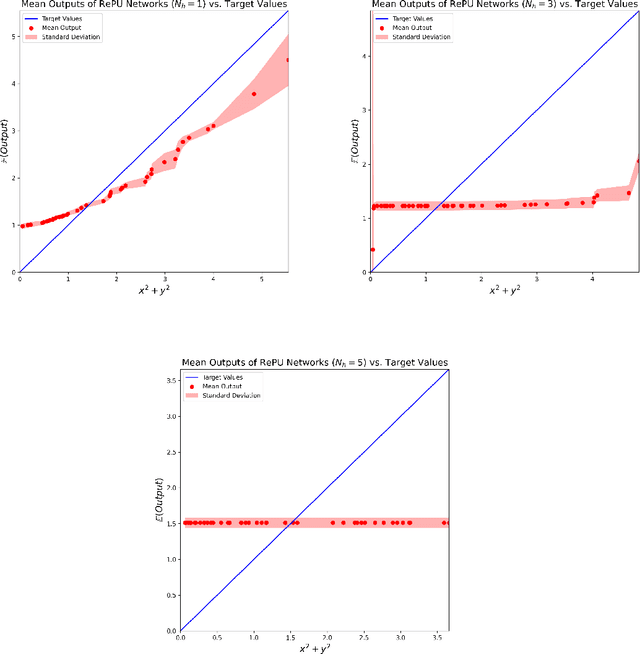
Abstract:The Rectified Power Unit (RePU) activation functions, unlike the Rectified Linear Unit (ReLU), have the advantage of being a differentiable function when constructing neural networks. However, it can be experimentally observed when deep layers are stacked, neural networks constructed with RePU encounter critical issues. These issues include the values exploding or vanishing and failure of training. And these happen regardless of the hyperparameter initialization. From the perspective of effective theory, we aim to identify the causes of this phenomenon and propose a new activation function that retains the advantages of RePU while overcoming its drawbacks.
Neural Operators Learn the Local Physics of Magnetohydrodynamics
Apr 24, 2024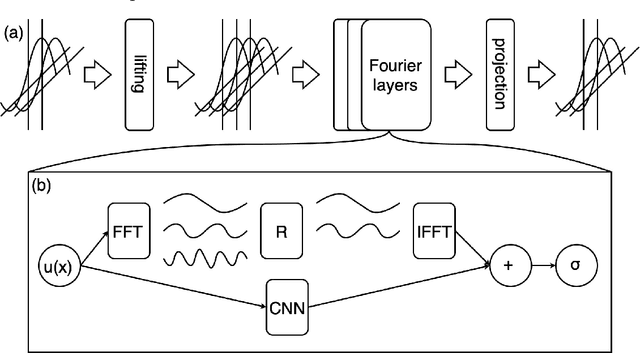
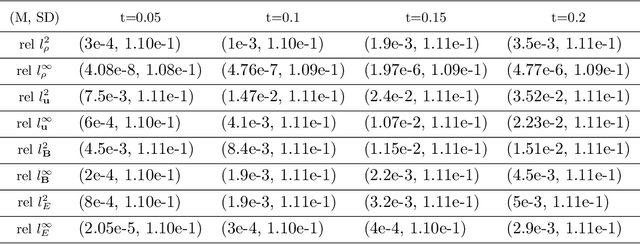
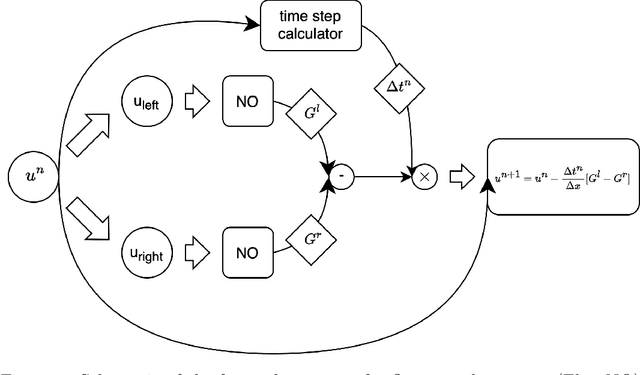
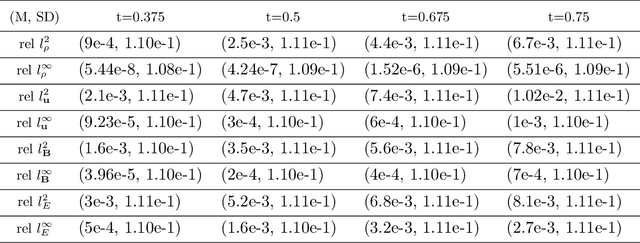
Abstract:Magnetohydrodynamics (MHD) plays a pivotal role in describing the dynamics of plasma and conductive fluids, essential for understanding phenomena such as the structure and evolution of stars and galaxies, and in nuclear fusion for plasma motion through ideal MHD equations. Solving these hyperbolic PDEs requires sophisticated numerical methods, presenting computational challenges due to complex structures and high costs. Recent advances introduce neural operators like the Fourier Neural Operator (FNO) as surrogate models for traditional numerical analyses. This study explores a modified Flux Fourier neural operator model to approximate the numerical flux of ideal MHD, offering a novel approach that outperforms existing neural operator models by enabling continuous inference, generalization outside sampled distributions, and faster computation compared to classical numerical schemes.
Approximating Numerical Fluxes Using Fourier Neural Operators for Hyperbolic Conservation Laws
Jan 17, 2024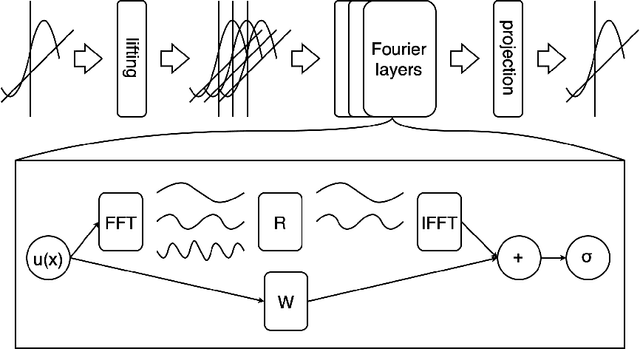
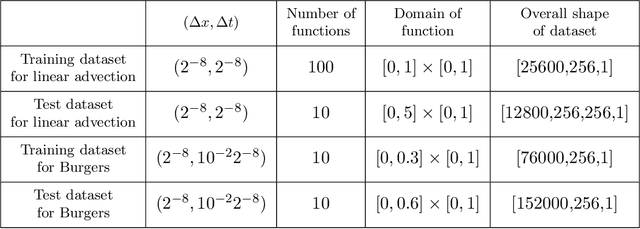
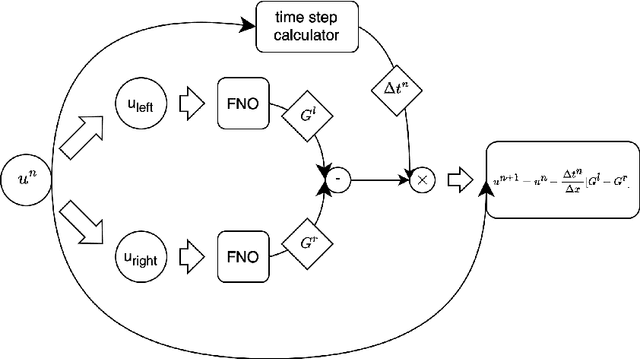

Abstract:Traditionally, classical numerical schemes have been employed to solve partial differential equations (PDEs) using computational methods. Recently, neural network-based methods have emerged. Despite these advancements, neural network-based methods, such as physics-informed neural networks (PINNs) and neural operators, exhibit deficiencies in robustness and generalization. To address these issues, numerous studies have integrated classical numerical frameworks with machine learning techniques, incorporating neural networks into parts of traditional numerical methods. In this study, we focus on hyperbolic conservation laws by replacing traditional numerical fluxes with neural operators. To this end, we developed loss functions inspired by established numerical schemes related to conservation laws and approximated numerical fluxes using Fourier neural operators (FNOs). Our experiments demonstrated that our approach combines the strengths of both traditional numerical schemes and FNOs, outperforming standard FNO methods in several respects. For instance, we demonstrate that our method is robust, has resolution invariance, and is feasible as a data-driven method. In particular, our method can make continuous predictions over time and exhibits superior generalization capabilities with out-of-distribution (OOD) samples, which are challenges that existing neural operator methods encounter.
An Infinite-Width Analysis on the Jacobian-Regularised Training of a Neural Network
Dec 06, 2023



Abstract:The recent theoretical analysis of deep neural networks in their infinite-width limits has deepened our understanding of initialisation, feature learning, and training of those networks, and brought new practical techniques for finding appropriate hyperparameters, learning network weights, and performing inference. In this paper, we broaden this line of research by showing that this infinite-width analysis can be extended to the Jacobian of a deep neural network. We show that a multilayer perceptron (MLP) and its Jacobian at initialisation jointly converge to a Gaussian process (GP) as the widths of the MLP's hidden layers go to infinity and characterise this GP. We also prove that in the infinite-width limit, the evolution of the MLP under the so-called robust training (i.e., training with a regulariser on the Jacobian) is described by a linear first-order ordinary differential equation that is determined by a variant of the Neural Tangent Kernel. We experimentally show the relevance of our theoretical claims to wide finite networks, and empirically analyse the properties of kernel regression solution to obtain an insight into Jacobian regularisation.
Virtual Action Actor-Critic Framework for Exploration (Student Abstract)
Nov 06, 2023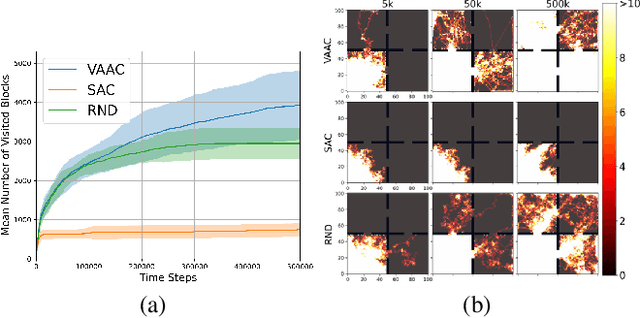

Abstract:Efficient exploration for an agent is challenging in reinforcement learning (RL). In this paper, a novel actor-critic framework namely virtual action actor-critic (VAAC), is proposed to address the challenge of efficient exploration in RL. This work is inspired by humans' ability to imagine the potential outcomes of their actions without actually taking them. In order to emulate this ability, VAAC introduces a new actor called virtual actor (VA), alongside the conventional actor-critic framework. Unlike the conventional actor, the VA takes the virtual action to anticipate the next state without interacting with the environment. With the virtual policy following a Gaussian distribution, the VA is trained to maximize the anticipated novelty of the subsequent state resulting from a virtual action. If any next state resulting from available actions does not exhibit high anticipated novelty, training the VA leads to an increase in the virtual policy entropy. Hence, high virtual policy entropy represents that there is no room for exploration. The proposed VAAC aims to maximize a modified Q function, which combines cumulative rewards and the negative sum of virtual policy entropy. Experimental results show that the VAAC improves the exploration performance compared to existing algorithms.
 Add to Chrome
Add to Chrome Add to Firefox
Add to Firefox Add to Edge
Add to Edge